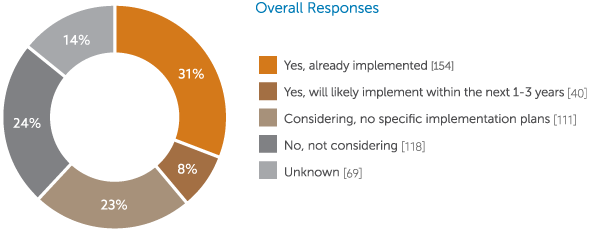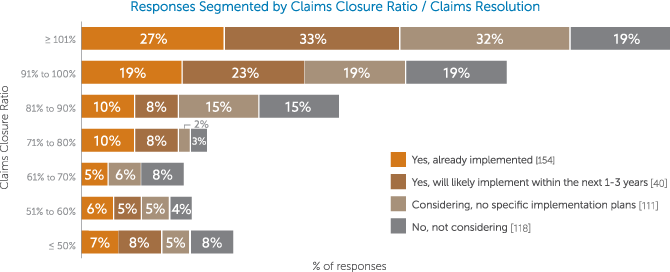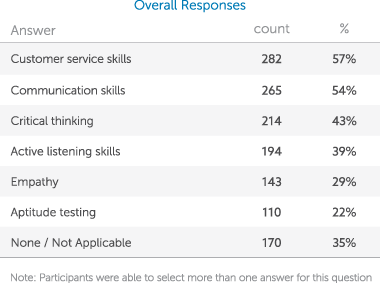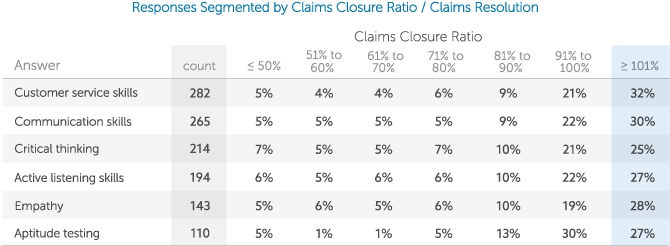How to Overcome Psychosocial Roadblocks:
Claims Advocacy’s Biggest Opportunity
BY: Peter Rousmaniere, Risk Management Consultant & Writer
& Rachel Fikes, VP & Study Program Director | Rising Medical Solutions

We know the single greatest roadblock to timely work injury recovery and controlling claim costs. And it’s not overpriced care, or doubtful medical provider quality, or even litigation. It is the negative impact of personal expectations, behaviors, and predicaments that can come with the injured worker or can grow out of work injury.
This suite of roadblocks is classified as “psychosocial” issues – issues which claims leaders now rank as the number one barrier to successful claim outcomes (Table 1) according to the Workers’ Compensation Benchmarking Study’s 2016 survey – and they drive up claim costs far more than catastrophic injuries, mostly due to delayed recovery.
Table 1. Ranking of greatest obstacles to achieving desired claim outcomes [492 responses]
 Source: Rising Medical Solutions’ 2016 Workers’ Compensation Benchmarking Study
Source: Rising Medical Solutions’ 2016 Workers’ Compensation Benchmarking Study
It’s likely no coincidence that while the industry has progressively paid more attention to psychosocial issues this past decade, there’s also been a shift towards advocacy-based claims models over adversarial, compliance, and task-based processing styles. Simply put, advocacy models – which treat the worker as a whole person – are better equipped to control or eliminate psychosocial factors during recovery.
So what can claims organizations do to become more advocacy-based, particularly related to overcoming psychosocial roadblocks? Reported here are key best practices, skill sets, and training approaches – rooted in advocacy – organizations are using to screen for, intervene in, and effectively address these critical barriers to recovery.
Currently, one-third of claims leaders report using advocacy-based claims models (Figure 1). Of these respondents, advocacy is more prevalent in higher performing claims organizations (Figure 2). The study also found that greater training in communication and soft skills, like empathy, is associated with higher performers (Tables 2 & 3).
Figures 1 & 2. Implementation/adoption rates of advocacy-based claims models
[492 responses]


Source: Rising Medical Solutions’ 2016 Workers’ Compensation Benchmarking Study
Psychosocial – What It Is, What It is Not
First, let’s take a brief look at what “psychosocial” is and, perhaps more importantly, what it is not.
The Hartford’s medical director, Dr. Marcos Iglesias, says that the “psych” part does not mean psychiatric issues, such as schizophrenia, personality disorders, or major depressive disorders. Instead, he points out, “We are talking about behavioral issues, the way we think, feel, and act. An example is fear of physical movement as it may worsen one’s impairment or cause pain, or fear of judgment by coworkers.” The Hartford’s text mining has found the presence of “fear” in claim notes was more predictive of poor outcomes than a lumbar fusion surgery. Similar findings were recently cited by both Lockton[i] and the Workers’ Compensation Research Institute (WCRI)[ii] which independently report that workers who express fear are at greater risk of poor outcomes.
“The ‘psych’ part does not mean psychiatric issues, such as schizophrenia…We are talking about behavioral issues, the way we think, feel, and act.”
– Dr. Marcos Iglesias, VP, Medical Director, The Hartford
There is no shortage of studies demonstrating the dramatic impact of psychosocial roadblocks and just how hard they are to manage. Lockton’s study directly links worker fears with high litigation rates. Another from the Journal of Occupational and Environmental Medicine found that injured workers with emotional distress, such as pain catastrophizing and activity avoidance, were seven times less likely than those in the low-risk group to return to work within three months.[iii]
Other conditions, behaviors, and predicaments include obesity, hard feelings about coworkers, troubled home life, the lack of temporary modified work assignments, limited English proficiency, and – most commonly noted – poor coping skills. Additionally, being out of work can lead to problems such as increased smoking, alcohol abuse, illicit drug use, and risky sexual behavior. Suicide rates have been observed to increase by a factor of six.[iiii]
When peeling back the psychosocial onion, one can see how adversarial, compliance, and task-driven claim styles are 1) ill-suited for addressing fears, beliefs, perceptions, and poor coping skills and 2) less likely to effectively address these roadblocks due to the disruption they pose to workflows and task timelines.
Screening & The One Big Question
Denise Algire is director of risk initiatives and national medical director for Albertsons Companies, with more than 285,000 employees in retail food and related businesses. Algire is also principal researcher and study report author of the Workers’ Compensation Benchmarking Study.
She says Albertsons uses a modified Linton tool for screening injured workers for psychosocial comorbidities. To ensure workers are comfortable and honest, the company enlists a third-party telephonic triage firm to perform screenings. It’s voluntary and confidential in details, with only a summary score shared with claims adjusters and case managers. So far, more than 10,000 screenings have been performed, typically within two weeks post-injury.
Says Algire, “These screening tools are only as good as the trust you’ve developed with workers. Countless studies have shown that questionnaire-takers and interviewees will often alter responses if they do not feel comfortable.” Several experts say their company makes a point of designing their screening tools to seem less like an extensive questionnaire “checklist,” which can appear cold and intimidating, and instead focus on collecting psychosocial information through more organic dialogue.
“These screening tools are only as good as the trust
you’ve developed with workers.”– Denise Algire, Director of Risk Initiatives & National Medical Director, Albertsons Companies
At The Hartford, Iglesias says claims adjusters ask one very important question of the injured worker, “Jim, when do you expect to return to work?” Any answer of less than 10 days indicates the worker has good coping skills and their risk of delayed recovery is low. That kind of answer is a positive flag for timely recovery. If the worker answers with a longer duration, the adjuster explores why the worker believes recovery will be more difficult. For example, the injured worker may identify a barrier of which the adjuster is unaware: their car may have been totaled in an accident. This lack of transportation, and not the injury, may be the return to work barrier.
It Takes a Village
Two of the strongest attributes of advocacy models is their team-based approach and their focus on the injured worker – as a whole person – as the customer at the center of a claim.
Trecia Sigle, Nationwide Insurance’s new associate vice president of workers’ compensation claims, is building a specialized team to address psychosocial roadblocks. “The workers’ compensation industry has just recently begun to pay more attention to the worker than to the injury,” she says. Nationwide’s intake process will consist of a combination of manual scoring and predictive modeling, and then adjusters will refer certain workers to specialists with the “right skill set.”
“The workers’ compensation industry has just recently begun to pay more attention to the worker than to the injury.”
– Trecia Sigle, AVP of Workers’ Compensation Claims, Nationwide
This can include enlisting cognitive behavioral therapy (CBT). “It’s only been in the past few years that the claims community has accepted CBT and similar approaches as valid claims resources,” Sigle says. Despite being around for years, she says that chronic pain has challenged claims organizations to take concerns of the injured worker more seriously since this pain is only loosely connected to the actual nature of injury.
At Albertsons, Algire says approximately nine percent of screened workers receive specialist intervention, which is usually performed by a network of psychologists who provide health coaching consistent with CBT principles. This intervention method is short in duration and focuses on active problem-solving with the patient.
Algire cautions that, with the long-tail nature of workers’ compensation claims, it will take three or four years before the strategy’s impact can be effectively measured in claim outcomes, but she is optimistic. Her tentative estimate is duration of disability and medical spending will decline by 20 percent.
Asked what she’s learned about psychosocial roadblocks over the past decade, Algire reiterates Sigle’s observations – these roadblocks occur regardless of the nature of injury. In other words, one cannot predict from medical data the presence of a psychosocial issue; one has to listen to the injured worker with a fresh mind.
Like Nationwide and Albertsons, adjusters at The Hartford also transfer cases where psychosocial issues appear important to a specialist team. Iglesias says these team members are selected for their listening, empathy, communication skills, and past claims experience, even if in a line other than workers’ compensation. Why? Iglesias says, “They understand what is going on in the injured person’s mind. And, they know when to refer back to the claims handler when their intervention is complete.”
These specialists reach out and offer a voluntary coaching program, called iRECOVER, and use phone calls along with a workbook and homework assignments. It can last several weeks whereby the specialist builds the worker’s awareness of all people, at work and family, for whom the worker’s recovery matters. They identify specific risk factors, and coach the worker how to cope. Sleep, diet, and getting through the day are topics that often arise.
Emotional Intelligence – Can It Be Learned?
Industry professionals are of mixed minds about how and if frontline claims adjusters can improve their interpersonal skills – sometimes called “emotional intelligence” – through training. These soft skills include customer service, communication, critical thinking, active listening, and empathy.
These same professionals wonder if they can ever influence worksite personnel to be more attentive to psychosocial issues. Renee-Louise Franche, a clinical psychologist specializing in work disability prevention, says that “when an injured worker perceives injustice in how they were injured and treated thereafter by their employer, it can drive a spike into recovery.” Can, or should, a claims adjuster attempt to lessen discord between the injured worker and their supervisor? And, if so, what skills would they need to do so?
Likewise, industry professionals cast doubt about how prepared medical providers are to pay attention to psychosocial roadblocks. A renowned former surgeon at Harvard Medical School says, even in 2017, it is common that young surgeons never receive serious coaching on addressing non-medical issues that can trip up recovery. Iglesias’ experience with medical providers supports this assertion. By focusing on finding medical diagnoses and prescribing medical solutions, they unintentionally encourage patients to find a medical cure for non-medical predicaments in life. The cure often fails. Therefore, it seems, a large portion of the burden lies with claims organizations to address psychosocial factors and this requires significant sensitivity and know-how.
Experts interviewed here agree that some claims adjusters have innately better soft skills and strengths for dealing with psychosocial issues. But they also concur that training and coaching can only enhance these skills among claims staff.
“With only a minority of cases being referred to specialists industrywide, claims adjusters carry the bulk of the communications load with this often fragile and distressed population.”
– Denise Algire, Director of Risk Initiatives & National Medical Director, Albertsons Companies
Nationwide is making a determined effort to help its adjusters grow in ways that build on their personal strengths. Asked if the insurer is drawing upon the experience of other industries for staff development, Sigle says there is no off-the-shelf process that fits her requirements. She’s building the development program internally.
Pamela Highsmith-Johnson, national director of case management at CNA, says the insurer introduced a “Trusted Advisor” training program for all employees who come into contact with injured workers. CNA’s Knowledge and Learning Group helped develop the training with internal claims and nurse staff. The team delivered a program designed with an ongoing curriculum, including regular “reminder” trainings. Small groups use role play and share ideas. An online training component is also included.
Algire says that with only a minority of cases being referred to specialists industrywide, claims adjusters carry the bulk of the communications load with this often fragile and distressed population. “I can’t overstate the need for professional training that supports the advocacy model of customer service,” she says. Particularly considering that adjusters are often inundated with cynical influences and information, “frequent trainings and reiterating of the purpose of the profession becomes all the more important.”
The current state of soft skills training by claims organizations leaves room for improvement (Table 2 ). However, notably, the more attention organizations paid to these skills, the better their claims closure ratios (Table 3).
Tables 2 & 3. Skills and abilities testing/training organizations conduct for frontline claims staff [492 responses]


Source: Rising Medical Solutions’ 2016 Workers’ Compensation Benchmarking Study
Advocacy – The Missing Link to Recovery
Noreen Olson, Workers’ Compensation Manager with Starbucks, has given one of the best definitions of claims advocacy in the industry. She says:
“In workers’ comp, advocacy is a process grounded by the values of dignity, respect, and transparency which coordinates activities to assist the injured worker effectively, promote expectancy and engagement in recovery, efficiently restores (and often improves upon) health and well-being, and resolves the experience in mutual satisfaction.”
Could it be that advocacy is the “missing link” for many existing claim practices to work, or work better? Whether for psychosocial issues or other barriers, organizations like The Hartford, Nationwide, CNA, and Albertsons are paving the road to a more effective approach. Participants in the 2016 Workers’ Compensation Benchmarking Study confirm that higher performing claims organizations are taking this road.
The upcoming 2017 Study will continue to survey claims leaders on advocacy topics. A copy of that report may be pre-ordered here.
[i] Lockton, Leading with Empathy: How Data Analytics Uncovered Claimants’ Fears. 2016
[ii] Workers Compensation Research Institute, Predictors of Worker Outcomes. 2014
[iii] Shaw W et al. The pain recovery inventory of concerns and expectations: A psychosocial screening instrument to identify intervention needs among patients at elevated risk of back disability. J Occup Environ Med. 2013 55 (8)
[iiii] Jin R et al. The impact of unemployment on health: a review of the evidence. Can Med Assoc. J. 1995 153 (5)





